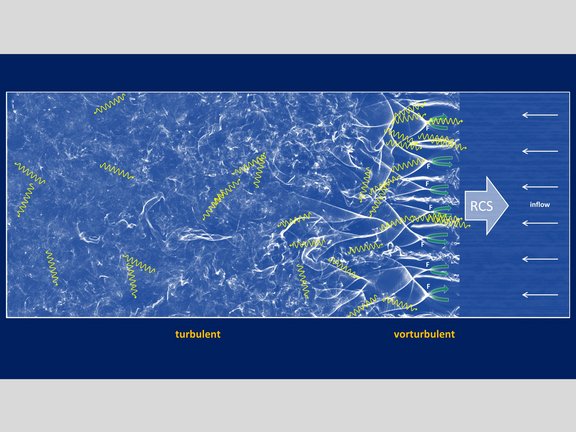Understanding the origin of extremely energetic cosmic rays and very high-energy gamma radiation leads to the question of particle acceleration in astrophysical plasmas. One mechanism already introduced by Enrico Fermi in 1949 in form of stochastic acceleration charged particles interacting with moving magnetic fields. One example are plasma shocks which are formed by supernova remnants or so-called relativistic collisionless shocks (RCS) in pulsar wind nebulae, active galactic nuclei and gamma-ray bursts (GRB). The latter are the most powerful explosions in the universe. Observations of the afterglow of GRB events indicate that RCS play a key role when the ultrarelativistic blast wave from the explosion expands into the external weakly magnetized medium. RCS brewed from GRB are dominated by electron-positron pairs created by the intense gamma radiation.
In a recent study, the group “relativistic and ultrashort quantum dynamics”, led by Karen Hatsagortsyan, in the division of Christoph Keitel at MPIK modelled the behaviour of such plasma shocks under initially unmagnetized conditions. Of particular interest is the polarization of photons emerging from the shock as a potential and essential information source for transient dynamics in astrophysical plasmas. In a RCS, plasma instabilities lead to filamentation and self-generated and magnetisation of microstructures. Under these turbulent conditions, electrons might experience stochastic acceleration akin to the Fermi process. However, the transition into the turbulent regime remained largely unexplored. In order to understand this in more detail and how this transition impacts the acceleration and radiation features in the RCS, the scientists employed a particle-in-cell (PIC) simulation of the RCS and examined the photon emission with emphasis on the polarization behaviour.
Two scenarios were considered related to the ratio of ions relative to the whole portion of positive charges (including the positrons). For a low ion ratio (about 1%), the photon emission is almost isotropic coming from the turbulent region with stochastic acceleration and the polarization shows a monotonic increase with the photon energy. In contrast a high ion ratio (about 40%) yields a photon emission which originates from the transition region of the RCS and is strongly collimated along the direction of the plasma flow (see Fig. 1). The polarization is no more monotonic and shows a minimum at intermediate energies as well as in the angular distribution at small emission angles.
“This can be understood by a slingshotlike acceleration of electrons”, says postdoc Zheng Gong who has recently left the division to work at Stanford University. The filamentation in the preturbulent region leads to a focusing of backward-moving electrons (denoted by “F” in Fig. 1) which in turn generates strong local electric fields. This configuration resembles a slingshot, where the filaments serve as the handhold, the backward-moving electrons with flowing focus points behave as the elastic string, and the injected forward-moving electrons are the projectiles (green arrows in Fig. 1). Under these conditions, the acceleration is strongly directed and much more efficient in contrast to the stochastic behaviour in the turbulent region. As a consequence, the photon emission from the slingshot process is also more directed and the photon spectrum is shifted to higher energies. In combination, this leads to an overall reduction of the polarization degree where the emission of both mechanisms contributes.
The mechanisms identified here and the photon polarization dependence could be tested in laboratory astrophysics by using high-energy ion and electron-positron beams. Moreover, the photon polarization is revealed as an essential probe in exploring transient dynamics in astrophysical as well as Earth-based plasmas.
Original publication:
Electron Slingshot Acceleration in Relativistic Preturbulent Shocks Explored via Emitted Photon Polarization
Zheng Gong, Xiaofei Shen, Karen Z. Hatsagortsyan and Christoph H. Keitel
Physical Review Letters 131, 225101 (2023). DOI: 10.1103/PhysRevLett.131.225101
Weblinks:
Group “Relativistic and Ultrashort Quantum Dynamics” (Division Keitel) at MPIK
